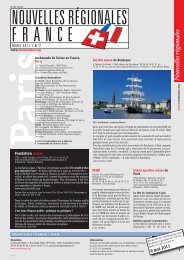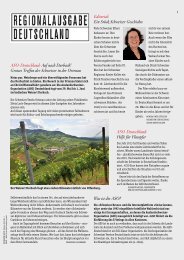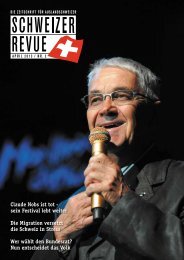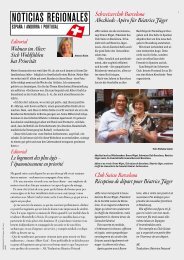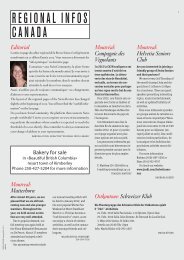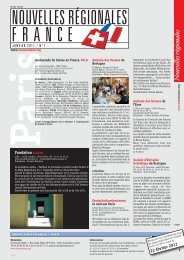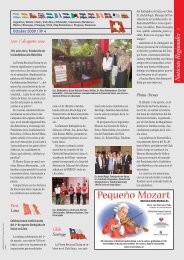Download PDF Swiss Review 1/2013 High Resolution
Download PDF Swiss Review 1/2013 High Resolution
Download PDF Swiss Review 1/2013 High Resolution
Create successful ePaper yourself
Turn your PDF publications into a flip-book with our unique Google optimized e-Paper software.
13<br />
ously, or a full-surface induction hob that<br />
only gets hot under the pan base. Visitors<br />
will enjoy not being approached immediately<br />
by salespeople and being able to look at and<br />
test out the exhibited items in peace. The<br />
displays are largely self-explanatory and<br />
nothing is sold. The advertising of the participating<br />
companies nevertheless has a<br />
strong presence. The German weekly newspaper<br />
“Die Zeit” very aptly described the<br />
Environment Arena as a “mixture of trade<br />
fair and technorama”.<br />
Revenue from the sale of Kompogas<br />
Walter Schmid constructed the Environment<br />
Arena without any public funding.<br />
The Zurich-based businessman became<br />
well-known in the 1990s as the founder of<br />
the company Kompogas and the inventor of<br />
systems that produce biogas from green<br />
waste. Schmid has a good track record in<br />
demonstrating his pioneering spirit for environmental<br />
issues with geothermal drilling<br />
and the construction of Minergie houses. He<br />
has since sold Kompogas to the energy group<br />
Axpo and invested 45 million <strong>Swiss</strong> francs of<br />
the proceeds in the Environment Arena. He<br />
is financing its operation through revenue<br />
from exhibition and sponsorship partners,<br />
which include many international corporations.<br />
Though, visitors also make a contribution,<br />
with adult entry tickets costing eight<br />
francs. 300,000 visitors a year are anticipated.<br />
However, according to its media<br />
spokesperson, the arena is only currently<br />
attracting 300 to 400 visitors on the four<br />
days a week that it is open.<br />
The new style is met with scepticism<br />
“Energy saving must become an experience”,<br />
declared Walter Schmid at the opening ceremony.<br />
He firmly believes that an energy<br />
turnaround is achievable without sacrifice.<br />
This outlook and conviction are omnipresent<br />
in the exhibitions. An energy-saving<br />
tumble drier, for instance, is available, while<br />
there is no mention of drying washing in the<br />
open air, which also saves a lot of energy.<br />
There is also no talk of switching to public<br />
transport at the Environment Arena, while<br />
the display of electric and hybrid vehicles<br />
takes up half a floor. The fact that tap water<br />
in Switzerland is on a par with bottled water<br />
is not highlighted anywhere either. The focus<br />
is instead on promoting PET recycling.<br />
The message is that every issue can be resolved<br />
by technology and that there is no<br />
need for changes in behaviour. Environmental<br />
organisations say politicians also like this<br />
standpoint as it is more appealing than calling<br />
for restrictions. Federal Councillor<br />
Leuthard believes that the Environment<br />
Arena has achieved a small miracle by making<br />
“the energy turnaround tangible”.<br />
Jürg Buri, Director of the <strong>Swiss</strong> Energy<br />
Foundation, has mixed feelings about the Environment<br />
Arena. He agrees that Walter<br />
Schmid has noble intentions. Buri remarks:<br />
“He is a progressive and successful individual<br />
who believes in sustainability.” There is absolutely<br />
nothing wrong with making money<br />
from environmental technologies, he says.<br />
However, if the “energy turnaround palace”<br />
is leading people to believe that climate<br />
change can be kept at bay solely with new<br />
technologies and without any change to behavioural<br />
patterns, then “the wool is being<br />
pulled over their eyes”.<br />
Environmentalists and climate protection<br />
campaigners have long distanced themselves<br />
from their image of cantankerous, woollysock-wearing<br />
advocates of community composting.<br />
Walter Schmid has certainly set new<br />
standards with his Environment Arena. His<br />
creation can barely be distinguished from the<br />
bright lights of unbridled commercialism in<br />
terms of aesthetics and size. “We are not used<br />
to people thinking big rather than small when<br />
it comes to the environment”, replies Buri<br />
from the Energy Foundation when questioned<br />
about the new style. It remains to be<br />
seen whether it can make a broader spectrum<br />
of the public aware of conscientious consumption.<br />
A married couple from Berne who came<br />
to Spreitenbach just to visit the Environment<br />
Arena say: “It’s great that it’s not just aimed at<br />
highly committed environmentalists.”<br />
The Environment Arena may well enliven<br />
the debate on climate change and sustainability<br />
in Switzerland. What the outcome will be<br />
is unclear. Somewhere in the halls of the Environment<br />
Arena, the expression “saying is<br />
one thing, doing is quite another” can be read.<br />
RETO WISSMANN is a freelance journalist living<br />
in Biel<br />
<strong>Swiss</strong> <strong>Review</strong> February <strong>2013</strong> / No. 1



